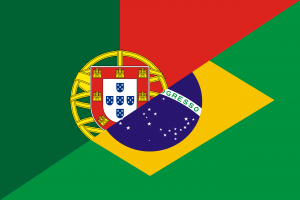Difference between revisions of "Language/Portuguese/Culture/Eating-Customs"
m (Quick edit) |
m (Quick edit) |
||
| Line 1: | Line 1: | ||
<span pgnav> | |||
{| class="wikitable pg_template_nav" | |||
|[[Language/Portuguese/Vocabulary/Drink|◀️ Drink — Previous Lesson]] | |||
|[[Language/Portuguese/Grammar/Regular-Verbs|Next Lesson — Regular Verbs ▶️]] | |||
|} | |||
</span> | |||
{{Portuguese-Page-Top}} | {{Portuguese-Page-Top}} | ||
| Line 115: | Line 122: | ||
{{Portuguese-Page-Bottom}} | {{Portuguese-Page-Bottom}} | ||
<span links></span> | <span links></span> | ||
<span pgnav> | |||
{| class="wikitable pg_template_nav" | |||
|[[Language/Portuguese/Vocabulary/Drink|◀️ Drink — Previous Lesson]] | |||
|[[Language/Portuguese/Grammar/Regular-Verbs|Next Lesson — Regular Verbs ▶️]] | |||
|} | |||
</span> | |||
Revision as of 17:27, 29 March 2023
| ◀️ Drink — Previous Lesson | Next Lesson — Regular Verbs ▶️ |
As a Portuguese language teacher, I always encourage my students to not only learn the language but also the culture and customs of the Portuguese-speaking world. In this lesson, we'll dive into Portuguese eating customs and traditions.
With the completion of this lesson, consider investigating these related pages: Portugal Timeline & Portugal.
Meals of the day
In Portugal, as in many other countries, there are three main meals of the day: breakfast (pequeno-almoço), lunch (almoço), and dinner (jantar).
Breakfast usually consists of coffee or tea, bread with butter or jam, and sometimes a pastry such as a croissant or pastel de nata (a traditional Portuguese egg tart).
Lunch is the biggest meal of the day and is usually eaten between 12:30 pm and 3 pm. In many work places, there is a two-hour lunch break to allow for a proper lunch. The meal typically includes soup, a main course (meat or fish with vegetables and/or rice), and dessert.
Dinner is a lighter meal than lunch and is usually eaten between 7 pm and 10 pm. It typically consists of soup or salad, a main course (sometimes just a sandwich or omelet), and fruit or a small dessert.
Table manners
In Portugal, it is considered polite to wait until everyone is served to start eating. It is also common practice to keep your hands visible during the meal, resting your wrists on the edge of the table.
When eating bread, break off small pieces and butter each piece individually. Do not butter the entire slice at once.
It is also considered polite to try a little bit of everything that is offered to you, even if it's something you don't normally eat.
Traditional dishes
Portugal is known for its delicious seafood dishes, and grilled sardines (sardinhas assadas) are a must-try. Other traditional dishes include:
- Cozido à portuguesa - a stew made with meat, vegetables, and beans
- Bacalhau - salt cod, prepared in many different ways
- Caldo verde - a soup made with kale and potatoes
- Francesinha - a sandwich made with steak, ham, and sausage, topped with melted cheese and a spicy tomato sauce
Desserts
Portugal has a great tradition of desserts and pastries, with many of them being famous worldwide. Here are some examples:
- Pastel de nata - a traditional egg tart pastry
- Arroz doce - a Portuguese-style rice pudding
- Toucinho do céu - a cake made with almond paste and egg yolks
- Pudim flan - a caramel custard, similar to crème brûlée
Vocabulary
Here are some vocabulary words to help you order food at restaurants or cafés in Portugal:
| Portuguese | Pronunciation | English |
|---|---|---|
| Com licença | kohm lee-SEN-sah | Excuse me (to get someone's attention) |
| Cardápio / Menu | kahr-DUH-pee-yoo / MEH-noo | Menu |
| Prato do dia | prah-too doo DEE-yah | Daily special |
| Sopa | SO-pah | Soup |
| Peixe | PEE-shuh | Fish |
| Carne | KAHR-nee | Meat |
| Frango | FRAHN-goh | Chicken |
| Porco | POHR-koo | Pork |
| Vegetariano | veh-geh-tah-ree-AH-noo | Vegetarian |
| Sobremesa | soh-breh-MEH-sah | Dessert |
| Bebida | beh-BEE-dah | Drink |
| Água | AH-gwah | Water |
| Chá | SHAH | Tea |
| Café | kah-FEH | Coffee |
| Cerveja | sehr-vay-zhah | Beer |
Conclusion
Portuguese eating customs and traditions are an important aspect of Portuguese culture, and I hope this lesson has helped you learn more about them. Remember, when learning a new language, it's not just about the vocabulary and grammar, but also about the customs and traditions that make the language unique.
Sources
Impressive work on finishing this lesson! Explore these additional pages to enhance your understanding: Portuguese from Portugal and Brazil & Transportation Customs.
Other Lessons
- Angola History
- Brazil Timeline
- Mozambique Timeline
- Cape Verde
- Angola
- Portuguese from Portugal and Brazil
- Portugal
- Emergency Services
- Música Popular Brasileira
- Live in Portugal
| ◀️ Drink — Previous Lesson | Next Lesson — Regular Verbs ▶️ |
